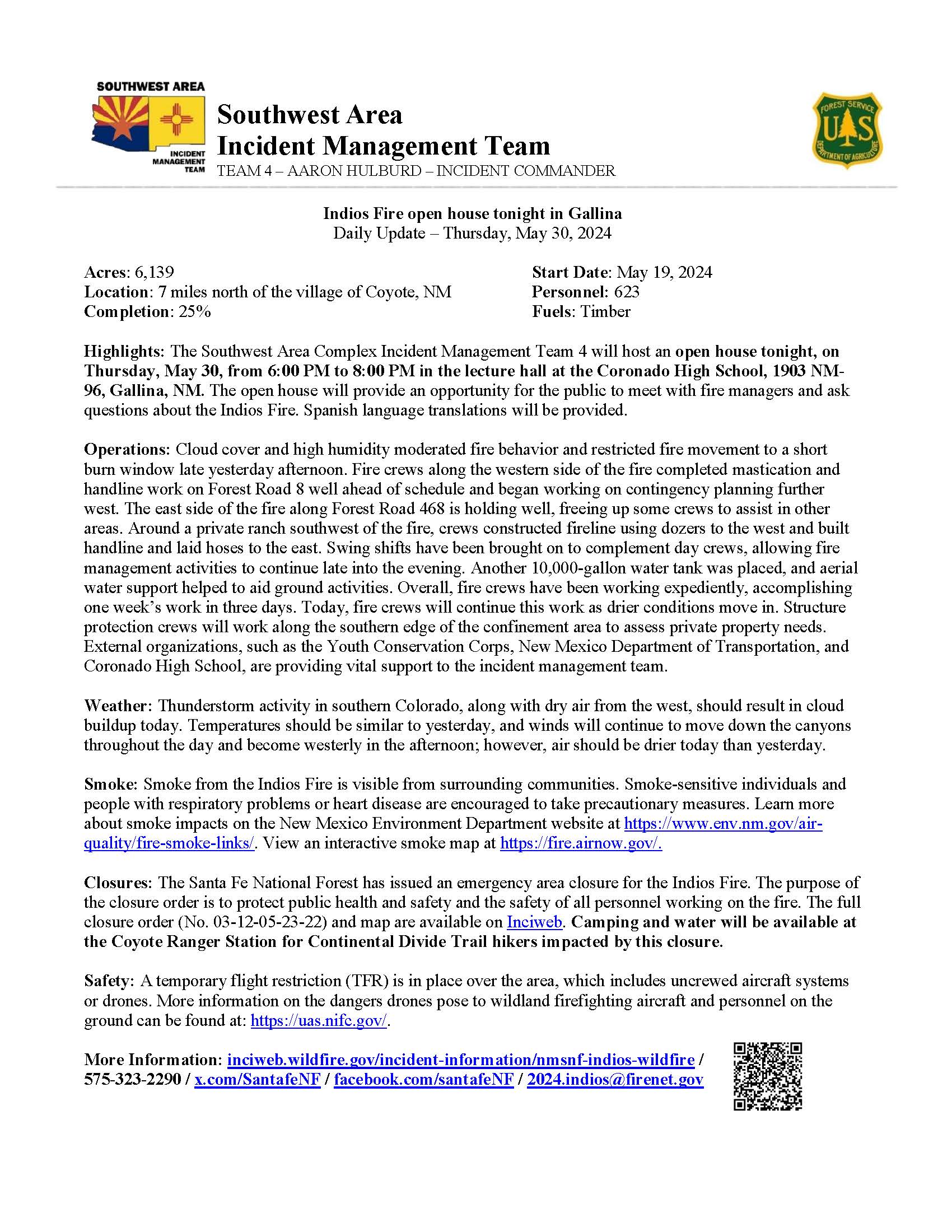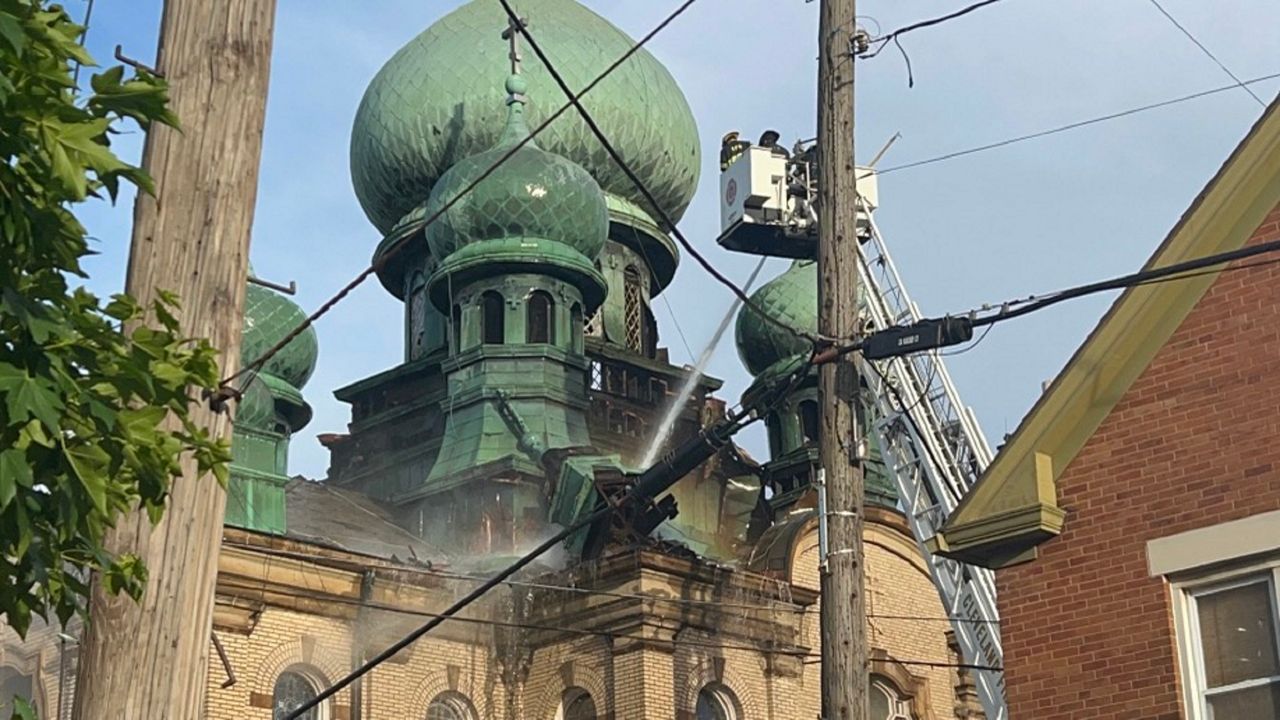New Mexico
Rio Grande managers in Texas, New Mexico hope for trickle of western drought money

New Mexico
May 30, 2024, Indios Fire Daily Update

SOUTHWEST AREA INCIDENT MANAGEMENT TEAM 4
AARON HULBURD – INCIDENT COMMANDER
Indios Fire open house tonight in Gallina
Acres: 6,139
Start Date: May 19, 2024
Location: 7 miles north of the village of Coyote, NM
Personnel: 623
Completion: 25%
Fuels: Timber
Highlights: The Southwest Area Complex Incident Management Team 4 will host an open house tonight, on Thursday, May 30, from 6:00 PM to 8:00 PM in the lecture hall at the Coronado High School, 1903 NM-96, Gallina, NM. The open house will provide an opportunity for the public to meet with fire managers and ask questions about the Indios Fire. Spanish language translations will be provided.
Operations: Cloud cover and high humidity moderated fire behavior and restricted fire movement to a short burn window late yesterday afternoon. Fire crews along the western side of the fire completed mastication and handline work on Forest Road 8 well ahead of schedule and began working on contingency planning further west. The east side of the fire along Forest Road 468 is holding well, freeing up some crews to assist in other areas. Around a private ranch southwest of the fire, crews constructed fireline using dozers to the west and built handline and laid hoses to the east. Swing shifts have been brought on to complement day crews, allowing fire management activities to continue late into the evening. Another 10,000-gallon water tank was placed, and aerial water support helped to aid ground activities. Overall, fire crews have been working expediently, accomplishing one week’s work in three days. Today, fire crews will continue this work as drier conditions move in. Structure protection crews will work along the southern edge of the confinement area to assess private property needs. External organizations, such as the Youth Conservation Corps, New Mexico Department of Transportation, and Coronado High School, are providing vital support to the incident management team.
Weather: Thunderstorm activity in southern Colorado, along with dry air from the west, should result in cloud buildup today. Temperatures should be similar to yesterday, and winds will continue to move down the canyons throughout the day and become westerly in the afternoon; however, air should be drier today than yesterday.
Smoke: Smoke from the Indios Fire is visible from surrounding communities. Smoke-sensitive individuals and people with respiratory problems or heart disease are encouraged to take precautionary measures. Learn more about smoke impacts on the New Mexico Environment Department website at https://www.env.nm.gov/air-quality/fire-smoke-links/. View an interactive smoke map at https://fire.airnow.gov/.
Closures: The Santa Fe National Forest has issued an emergency area closure for the Indios Fire. The purpose of the closure order is to protect public health and safety and the safety of all personnel working on the fire. The full closure order (No. 03-12-05-23-22) and map are available on Inciweb. Camping and water will be available at the Coyote Ranger Station for Continental Divide Trail hikers impacted by this closure.
Safety: A temporary flight restriction (TFR) is in place over the area, which includes uncrewed aircraft systems or drones. More information on the dangers drones pose to wildland firefighting aircraft and personnel on the ground can be found at: https://uas.nifc.gov/.
More Information: inciweb.wildfire.gov/incident-information/nmsnf-indios-wildfire /
575-323-2290 / x.com/SantafeNF / facebook.com/santafeNF / 2024.indios@firenet.gov
New Mexico
RECRUITING: New Mexico Gatorade Player of The Year Visiting UTSA & UTEP in June

At al levels of football, coaching staffs spend the summer months putting in the time to try and build their rosters for future seasons. A big part of that is hosting desires recruits on official visits.
One such recruit, 2025 quarterback/athlete Cam Dyer of Albuquerque, New Mexico’s La Cueva High School will take official visits to two G5 schools in Texas in the month of June. Dyer confirmed on social media and to Rivals.com that he will soon visit Scotty Walden’s UTEP program (June 10) and Jeff Traylor’s UTSA program (June 14). Dyer also his other official visits locked in for Utah and Arizona State.
Colorado Buffaloes Transfer Lineman Decides On G5 Destination
Per an interview with Rivals’ Parker Thune, Dyer has indicated that the Miners and Roadrunners are recruiting him as a quarterback, where as others as an athlete or a defensive back.
Dyer, a three-star prospect (On3) measuring in at 6’4″ and 205 pounds, was named the state of New Mexico’s Gatorade Player of the Year after leading La Cueva to the state 6A title.
RECRUITING: Utah State Hosting Elite 11 QB This Week
As of May 30, Dyer reportedly has 14 Division I scholarship offers. He threw for over 2400 yards and rushed for over 1300 as a junior in 2023.
Per current rules, NCAA recruits are able to take as many official visits as they please, but can only schedule one per school. Early signing day for 2025 football recruits is December 4, 2024.
New Mexico
House Speaker Johnson opposes radiation compensation for Missouri, New Mexico • Kentucky Lantern

Offering compensation to thousands of Americans across nine states exposed to radiation from the nation’s nuclear weapons program would be too expensive, U.S. House Speaker Mike Johnson’s office said Wednesday.
With less than two weeks until the existing Radiation Exposure Compensation Act expires, a spokesperson in Johnson’s office said the speaker supports renewing the program where it already exists but not expanding it, creating a huge obstacle for advocates and cancer patients from St. Louis to the Navajo Nation who were exposed to bomb testing or nuclear waste.
“House Republican Leadership is committed to ensuring the federal government fulfills its existing obligations to Americans exposed to nuclear radiation,” the spokesperson said in a statement to The Independent. “Unfortunately, the current Senate bill is estimated to cost $50-60 billion in new mandatory spending with no offsets and was supported by only 20 of 49 Republicans in the Senate.”
The Radiation Exposure Compensation Act, or RECA, originally passed by Congress in 1990, offers compensation to uranium miners and civilians who were downwind of nuclear bomb testing in Arizona, Utah and Nevada. It expires June 10, and for months, advocates and members of Congress — especially from Missouri and New Mexico — have been lobbying Congress to expand it.
U.S. senators have twice passed legislation that would expand RECA, but it hasn’t gone anywhere in the House of Representatives. The legislation would add the remaining parts of Arizona, Utah and Nevada to the program and bring coverage to downwinders in Colorado, Idaho, Montana, New Mexico and Guam. It would also offer coverage for residents exposed to radioactive waste in Missouri, Tennessee, Alaska and Kentucky.
Dawn Chapman, who co-founded Just Moms STL to advocate for communities affected by World War II-era nuclear waste that contaminated parts of the St. Louis area, called Johnson’s statement “shocking.”
“I think that’s a pitiful excuse,” Chapman said of the limited Republican support. “I think that there isn’t even an excuse for the fiscal conservatives that say, ‘Put America first,’ because they clearly didn’t do that.”
Chapman and supporters of the legislation believe the $50-60 billion price tag is an overestimation, and she noted that cost is spread over five years.
She said supporters have worked to cut the costs of the program, including narrowing the list of health conditions that would qualify for compensation. If costs were a concern, Chapman said, Johnson should have met with advocates to work on further cuts.
Chapman said she’d return to Washington, D.C., next week, and “the least he can do is meet with us for 10 minutes.”
Johnson’s position was revealed Tuesday evening on social media by U.S. Sen. Josh Hawley, a Missouri Republican, and sparked outrage among the state’s congressional delegation.
U.S. Reps. Cori Bush, a Democrat from St. Louis, and Ann Wagner, a Republican from the nearby suburbs, vowed to oppose any extension of RECA that didn’t add Missouri.
On social media Wednesday afternoon, Hawley said the federal government “has not begun to meet its obligations to nuclear radiation victims.”
“(Missouri) victims have gotten zilch,” Hawley said.
Parts of the St. Louis area have been contaminated for 75 years with radioactive waste left over from the effort to build the world’s first atomic bomb during World War II. Uranium refined in downtown St. Louis was used in the first sustained nuclear chain reaction in Chicago, a breakthrough in the Manhattan Project, the name given to the effort to develop the bomb.
After the war, waste from uranium refining efforts was trucked from St. Louis to surrounding counties and dumped near Coldwater Creek and in a quarry in Weldon Spring, polluting surface and groundwater. Remaining waste was dumped at the West Lake Landfill in Bridgeton, where it remains today.
Generations of St. Louis-area families lived in homes near contaminated sites without warning from the federal government. A study by the federal Agency for Toxic Substances and Disease Registry found exposure to the creek elevated residents’ risk of cancer. Residents of nearby communities suffer higher-than-normal rates of breast, colon, prostate, kidney and bladder cancers and leukemia. Childhood brain and nervous system cancers are also higher.
This story is republished from the Missouri Independent, a sister publication to the Kentucky Lantern and part of the nonprofit States Newsroom network.
-

 Culture1 week ago
Culture1 week agoFrom Dairy Daddies to Trash Pandas: How branding creates fans for lower-league baseball teams
-

 News1 week ago
News1 week agoRed Lobster files for bankruptcy after missteps including all-you-can-eat shrimp
-

 News1 week ago
News1 week agoThe states where abortion is on the ballot in November : Consider This from NPR
-

 Politics1 week ago
Politics1 week agoMichael Cohen swore he had nothing derogatory on Trump, his ex-lawyer says – another lie – as testimony ends
-

 News1 week ago
News1 week agoRead Prosecutors’ Filing on Mar-a-Lago Evidence in Trump Documents Case
-
News1 week ago
Trump's social media account shares a campaign video with a headline about a 'unified Reich'
-

 Science1 week ago
Science1 week agoPregnant? Researchers want you to know something about fluoride
-

 Politics1 week ago
Politics1 week agoAnti-Israel agitators interrupt Blinken Senate testimony, hauled out by Capitol police
















